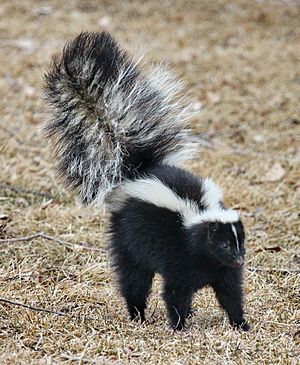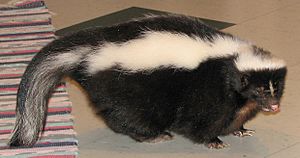Skunk facts for kids
Quick facts for kids Skunks |
|
|---|---|
 |
|
| Striped skunks | |
| Scientific classification | |
| Kingdom: | |
| Phylum: | |
| Class: | |
| Order: | |
| Family: |
Mephitidae
|
| Genus: | |
Skunks are small mammals found in North and South America. They belong to the Mephitidae family, which means 'stink' – a perfect name for these animals! Skunks are known for their special ability to spray a very strong, unpleasant liquid.
Even though they are related to polecats and other animals in the weasel family, skunks are most closely related to stink badgers from other parts of the world. Skunks come in different colors like black-and-white, brown, cream, or ginger. All skunks have special warning colors to tell other animals to stay away.
Contents
What Do Skunks Look Like?
Skunks come in different sizes. They can be about 15.6 to 37 inches (40 to 94 cm) long. Their weight varies from about 1.1 pounds (0.5 kg) for spotted skunks to 18 pounds (8.2 kg) for hog-nosed skunks.
Skunks have bodies that are a bit long. They have short, strong legs and long front claws. These claws are great for digging in the ground.
Most skunks are black and white, but some can be brown, grey, or even cream-colored. All skunks have stripes, right from when they are born! Some have one thick stripe down their back and tail. Others have two thinner stripes. Spotted skunks have white spots and broken stripes. Some skunks even have stripes on their legs.
They have five toes on each foot.
What Do Skunks Eat?
Skunks are omnivores, which means they eat both plants and animals. Their diet changes depending on the season. They enjoy eating insects, larvae (young insects), earthworms, grubs, rodents, lizards, salamanders, frogs, snakes, birds, moles, and eggs. They also like berries, roots, leaves, grasses, fungi, and nuts.
In areas where people live, skunks often look for food in garbage. Sometimes, skunks act as scavengers, eating dead birds or rodents left by other animals. If you have pets, a skunk might even find its way into your garage or basement to find pet food. Skunks often dig small holes in lawns to find grubs and worms.
Skunks are one of the main animals that hunt honeybees. Their thick fur helps protect them from stings. A skunk will scratch the front of a beehive. When the guard bees come out to see what's happening, the skunk eats them. Mother skunks teach their young how to do this. In California, skunks also dig up yellow-jacket nests in the summer.
How Skunks Behave
Skunks are crepuscular, meaning they are most active at dawn and dusk. They are usually alone when they are not breeding. However, in colder places, many skunks might gather in one den to stay warm. During the day, they rest in burrows that they dig with their strong front claws.
Male and female skunks have areas where they live and hunt. These areas often overlap. Females usually cover about 2 to 4 square kilometers (0.8 to 1.5 sq mi), while males can cover up to 20 square kilometers (7.7 sq mi).
Skunks don't truly hibernate in winter. Instead, they go into a deep sleep for long periods. They are not very active and don't eat much. During winter, several female skunks (sometimes up to 12) huddle together. Males often stay alone. They often use the same den every winter.
Skunks have excellent senses of smell and hearing. However, their eyesight is poor. They can't see things clearly if they are more than about 3 meters (10 ft) away. This poor vision makes them more likely to be hit by cars. Skunks don't live very long in the wild, usually only up to a year, but they can live up to seven years. In zoos or as pets, they might live for up to 10 years.
Skunk Reproduction and Life Cycle
Skunks mate in early spring. One male skunk might mate with several females. Before giving birth, usually in May, the female skunk digs a den for her babies. Skunk babies are called kits. A mother skunk usually has four to seven kits. The kits grow inside the mother for about 66 days.
When skunk kits are born, they are blind and deaf. They are covered in soft fur. Their eyes open about three weeks after they are born. The kits stop drinking their mother's milk about two months after birth. They usually stay with their mother until they are about one year old and ready to have their own babies.
The mother skunk protects her kits very well. She will spray if she senses any danger. The male skunk does not help raise the young.
Skunk Spray: Their Special Defense

Skunks are famous for their special scent glands near their anus. These glands are like a powerful defensive weapon. Skunks have two glands, one on each side of their anus. These glands make the skunk's spray. The spray is a mix of chemicals that contain sulfur, which causes the very strong, bad smell.
A skunk's spray is strong enough to scare away big animals like bears. Skunks have strong muscles near these glands. These muscles let them spray very accurately, up to 3 meters (10 ft) away! The spray can also make eyes sting and even cause temporary blindness. Humans can smell the spray from as far as 5.6 kilometers (3.5 miles) away if the wind is blowing the right way.
Skunks don't like to use their spray unless they have to. They only carry enough for about five or six sprays. It takes them about ten days to make more. Their bold black and white colors are a warning sign. It's better for a skunk to warn a predator without using its spray.
Before spraying, a threatened skunk will hiss, stomp its feet, and raise its tail. They do this to try and scare away the danger first. Skunks usually don't spray other skunks, except sometimes during mating season if males are fighting. If they fight over den space in the autumn, they use their teeth and claws.
Most predators in the Americas, like wolves, foxes, and badgers, usually avoid skunks. This is because they don't want to get sprayed. The only animals that regularly hunt skunks are dogs (who might not know better) and the great horned owl. Owls are the skunk's main natural enemy. In one owl nest, people found the remains of 57 striped skunks!
Skunks are common in towns and cities. Because they often meet dogs and other pets, and because their spray smells so bad when they are hit by cars, many ideas exist about how to remove skunk odor. Most home remedies don't work well because of the chemicals in the spray. The The Humane Society of the United States suggests using a mix of hydrogen peroxide, baking soda, and dishwashing soap for pets.
Skunk Bites and Rabies
It is very rare for a healthy skunk to bite a human. If a tame skunk (one kept as a pet) has had its scent glands removed, it might bite to defend itself. However, there are not many reports of this happening.
The most common reason a skunk might bite a human is if it has the rabies virus. Skunks are known carriers of rabies. In 2006, about 21.5% of all reported rabies cases in the United States were from skunks. Skunks are second only to raccoons as animals that carry rabies. However, this can change depending on the area.
Skunks as Pets
The striped skunk (Mephitis mephitis) is the most social type of skunk. It is also the kind most often kept as a pet. In the United States, it is legal to own skunks as pets in seventeen states. When a skunk is kept as a pet, its scent glands are often removed through surgery. In the UK, skunks can be pets, but a law from 2006 made it illegal to remove their scent glands there.
Images for kids
-
A hooded skunk skeleton on display at the Museum of Osteology





